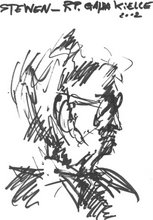I was thinking that it might be nice to put some local news items in this blog to give a more general idea of where I live, so I looked in the local newspaper and found this item about the local nursery school. Its one of those heart-warming, "isn't life wonderful" stories, which I rather liked. My translation may not be perfect, but I hope the spirit of the original survives.
Nadarzyn News - February 2009
Local Authority Newspaper
The Public Nursery School in MłochówGRANNY'S And GRANDDAD'S DAY"No one else is in a position to give children what grandparents provide:
they sprinkle the dust of stars on the lives of their grandchildren.”
A. Haley
From the beginning of January, the children in the nursery school were already preparing themselves for this important day. After all, grandparents – loving and dear, warm and understanding - forgive their beloved grandchildren for even their worst naughtiness.
We began with the preparation of the repertoire, then we designed the invitations for our special guests:
My dears, the time is near
We want you with us here.
Free time please set aside,
Our door we'll open wide.
Because now we wish to invite you,
There's a show that will delight you.
It will be a very great display
Grannies' Day and Grandpas' Day.
For you shall not regret
Your spare time that you set
Get ready soon to move
To the Public Nursery School
In Młochów (Mwo-hoov).
For two weeks, the children were absorbed in preparing presents - surprises and cards. This year, all the groups prepared 2009 calendars for their Grandmothers and Grandfathers. (Every group according to their own ideas, of course). Then the children created greeting cards. Next came portraits of their darling Grandma, oh, and their beloved Grandpa, of course. A lot of time was devoted to creating the artistic part of the show (songs, poetry, dances).
At last, the long-awaited day came. From 14.00, the invited guests began to assemble in the gymnasium. The nursery school children could not wait to see their grandparents, but at the beginning they had to make do with a quick kiss – only after the performance would there be time to nestle on the shoulders of Granny and Grandpa.
Performances began by the "Middles", after them came the "Little Ones" and then came the "Elders". Every group had in its own repertoire of poetry, songs, dances and instrumental performances. The children did not expect such a hot reaction during the performance: loud cheers, whooping grandfathers. Cries of "Bravo!", Super!”, "Good, Good!, etc" are only some of the calls of joy and satisfaction coming from the guests.
After the performance, the grandchildren could at last embrace their Grannies and Granddads in their own rooms during a shared tea-party. The nursery school children were not a disappointment here either and showed, with good manners, their respect towards their guests – first they found seats for Grandma and Grandpa, and sat themselves down only if there was a vacant seat or they sat on Granny's lap. They treated their guests to sandwiches and tea. Last of all, every child handed over the personally made presents and greetings card.
For the nursery school children, this was one of most eagerly awaited and happy days. Grandparents took the day off on work especially for them, and came from different parts of Poland to view their performance: just so that they could stay with them for these few moments. For these guests, the details were not important (not standing straight, unfinished lines, etc). Of importance was just the grandson or granddaughter, after all they are even more their darlings than their own children.
It was clear that between grandparents and grandchildren there is such a wonderful bond. Grandparents almost always know what it means to bring up their grandchildren patiently and with smiles, to speak calmly and brightly, to joke, to play and to make them happy. The child knows that busy and hard-working parents do not have not time to listen, but grandparents will always will find the time, will listen, will console, will advise, and will simply interest themselves in the problems. It doesn't matter whether the child is nursery or junior school, the child's problem is important, even if it is just about a broken toy car or doll.
Grandma and Granddad are as irreplaceable now as they have always been: ready to sacrifice their own time, to care, be patient, and give their hearts to their beloved grandchildren.
Bożena Grochowska
The Public Nursery School in Młochów
 The Church
The Church Alongside the many Nadarzyn resident visitors and their guests, were the representatives of Nadarzyn Gmina local authority, of course, with Mayor Janusz Grzyb at their head, plus a delegation from the friendly Ukrainian Gmina of Hostomel with Mayor Anatoli Kiriczenko. The Picnic concluded with a concert by Orchestra OSP Nadarzyn under the leadership of Mirosław Chilmanowicz.
Alongside the many Nadarzyn resident visitors and their guests, were the representatives of Nadarzyn Gmina local authority, of course, with Mayor Janusz Grzyb at their head, plus a delegation from the friendly Ukrainian Gmina of Hostomel with Mayor Anatoli Kiriczenko. The Picnic concluded with a concert by Orchestra OSP Nadarzyn under the leadership of Mirosław Chilmanowicz. The Palace, with children's playground to the left.
The Palace, with children's playground to the left.




















